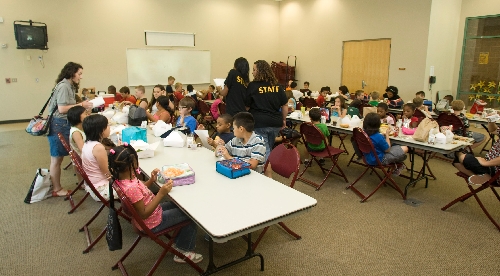Demand for schools’ summer food program could explode next year
Billy Jean Ewell's 10-year-old grandson Jacob King can easily down three cartons of milk at the summer lunch program at the Hollywood Recreation Center in east Las Vegas.
"He's growing," Ewell said. "He eats more than he's ever thought about eating."
The Summer Food Service Program serves about 4,000 meals a day to kids in Clark County. The appetite for chicken nuggets, meatloaf sandwiches and baby carrots is expected to grow even larger next summer when 76 year-round elementary schools will no longer be in session.
Karen Vogel, the nutrition consultant for the state Department of Education, estimates 20,000 low-income children will no longer have free or reduced-price school breakfasts and lunches available to them.
The Clark County School District is converting all its year-round schools to 9-month calendars as a cost-savings measure.
"Next summer, you're going to have all children out at the same time. It's going to create a demand all at once," said state Sen. Steven Horsford, D-Las Vegas, whose regular job is chief executive officer of the Culinary Training Academy. The academy is the largest sponsor of the Summer Food Service Program in Clark County, having served 41,000 meals in June.
Tim Adams, principal of year-round Bell Elementary School, 2900 Wilmington Way, near Sahara and Interstate 15, is worried because 83 percent of his students qualify for free and reduced lunches.
"I do have a concern," Adam's said. "What's going to happen for three months for students who are living in poverty and going hungry? Where are they going to get their food?"
That's where the Summer Food Service Program comes in, Vogel said. It's "intended to fill in the gap when children are on vacation from school and do not have access to the National School Lunch Program." Both are federal programs.
Feeding sites selected for the Summer Food Service Program are usually within "walking distance," about a mile or so, of a school where more than half the students qualify for free and reduced lunches. The chosen sites are typically places that already cater to youth, such as Boys and Girls Clubs, recreation centers or YMCAs.
Summer Food Service Program officials hope to absorb the demand next summer by opening new sites around the former year-round schools and increasing the volume of meals served at established locations. Cost is not expected to be an obstacle, Vogel said.
The U.S. Department of Agriculture reimburses sponsors for the costs of the meals. The amount of money coming in depends upon the number of meals served by sponsors to needy children, Vogel said. Last summer, the state was reimbursed for $1.3 million, including $669,432 for Clark County.
Neighbors for Nutrition is a coalition of local sponsors that promotes the program in Clark County.
Julie Murray, president of Three Square food bank, said Neighbors for Nutrition is "giving a lot of attention right now to next summer. We're doing a gap analysis of the community (to find) the pockets or places of need."
Murray said her goal is to create neighborhood maps of summer lunch sites for schools to give to families at the end of the 2010-11 school year.
Participation in the summer food program has been relatively low in Clark County, perhaps because so many kids were served at school in the summer months. While Clark County has about 70 percent of the K-12 students in Nevada, just over half the meals served by the Summer Food Service Program in 2009 were consumed by local youth.
Clark County kids ate 257,380 of the 501,561 meals served in Nevada.
Vogel said the program seems to be more established in Northern Nevada. Reno has 30 feeding sites, including many in city parks. She suggested that the heat, traffic and lack of transportation to feeding sites might be obstacles to participation in Clark County.
Others suggested that lack of awareness and pride also might be factors.
Ewell said her minister urged her to take her grandson to the lunch program to help justify the service and make it available to others.
Matt Brown, the director of the Hollywood Recreation Center, said he will often go outside to the playground to invite kids in for lunch. This summer, there are more than 30 sites in Southern Nevada where anyone 18 or younger can show up and receive a free meal.
Because summer food program sites often lack the means to serve hot foods, meals are usually cold sandwiches and fruit cups from Three Square or the Culinary Training Academy.
The Hollywood Recreation Center, 1650 S. Hollywood Blvd., just became a lunch site this summer.
Many families in the east valley neighborhood are losing their homes to foreclosure, said Ewell and her friend Maria Sanchez, whose six children also take advantage of the summer lunch program.
Sanchez said the lunch program is good for the family budget.
"It helps with the milk. We do about 15 gallons of milk (a week)," Sanchez said. "Six kids, plus mom and dad, it's like we use one gallon a meal. So it's hard."
Ewell said the experience can be awkward. The Hollywood Recreation Center does not allow adults in the lunchroom until after its day campers have finished eating. Her grandson has Asperger's syndrome, an autism-like disorder, and likes her to be with him when he eats, Ewell said.
Brown, the director, said limiting adult access to the lunchroom is a security precaution, but Ewell feels the policy should change.
"I feel I am being treated as a second-class citizen," Ewell said. "This is a community program, it's not a (day camp) program."
Contact reporter James Haug at jhaug@review journal.com or 702-374-7917.
Summer Food Service Program sites in Las Vegas Valley


















